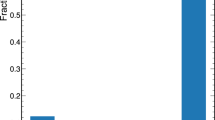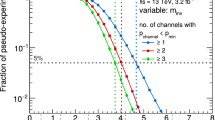Abstract
In 2018, the STAR collaboration collected data from \(_{44}^{96}{\mathrm{Ru}}+_{44}^{96}{\mathrm{Ru}}\) and \(_{40}^{96}{\mathrm{Zr}}+_{40}^{96}{\mathrm{Zr}}\) at \(\sqrt{s_\text {NN}}=200\) GeV to search for the presence of the chiral magnetic effect in collisions of nuclei. The isobar collision species alternated frequently between \(_{44}^{96}{\mathrm{Ru}}+_{44}^{96}{\mathrm{Ru}}\) and \(_{40}^{96}{\mathrm{Zr}}+_{40}^{96}{\mathrm{Zr}}\). In order to conduct blind analyses of studies related to the chiral magnetic effect in these isobar data, STAR developed a three-step blind analysis procedure. Analysts are initially provided a “reference sample” of data, comprised of a mix of events from the two species, the order of which respects time-dependent changes in run conditions. After tuning analysis codes and performing time-dependent quality assurance on the reference sample, analysts are provided a species-blind sample suitable for calculating efficiencies and corrections for individual \(\approx 30\)-min data-taking runs. For this sample, species-specific information is disguised, but individual output files contain data from a single isobar species. Only run-by-run corrections and code alteration subsequent to these corrections are allowed at this stage. Following these modifications, the “frozen” code is passed over the fully un-blind data, completing the blind analysis. As a check of the feasibility of the blind analysis procedure, analysts completed a “mock data challenge,” analyzing data from \({\mathrm{Au}}+{\mathrm{Au}}\) collisions at \(\sqrt{s_\text {NN}}=27\) GeV, collected in 2018. The \({\mathrm{Au}}+{\mathrm{Au}}\) data were prepared in the same manner intended for the isobar blind data. The details of the blind analysis procedure and results from the mock data challenge are presented.

Similar content being viewed by others
References
B.I. Abelev, M.M. Aggarwal, Z. Ahammed et al., Azimuthal charged-particle correlations and possible local strong parity violation. Phys. Rev. Lett. 103, 251601 (2009). https://doi.org/10.1103/PhysRevLett.103.251601
B.I. Abelev, M. M. Aggarwal, Z. Ahammed et al., Observation of charge-dependent azimuthal correlations and possible local strong parity violation in heavy ion collisions. Phys. Rev. C 81, 054908 (2010). https://doi.org/10.1103/PhysRevC.81.054908
G. Wang, Search for chiral magnetic effects in high-energy nuclear collisions. Nucl. Phys. A 904–905, 248c–255c (2013). https://doi.org/10.1016/j.nuclphysa.2013.01.069
D. Kharzeev, Parity violation in hot QCD: Why it can happen, and how to look for it. Phys. Lett. B 633, 260–264 (2006). https://doi.org/10.1016/j.physletb.2005.11.075
D.E. Kharzeev, L.D. McLerran, H.J. Warringa, The Effects of topological charge change in heavy ion collisions: ‘Event by event P and CP violation’. Nucl. Phys. A 803, 227–253 (2008). https://doi.org/10.1016/j.nuclphysa.2008.02.298
S.A. Voloshin, Parity violation in hot QCD: how to detect it. Phys. Rev. C 70, 057901 (2004). https://doi.org/10.1103/PhysRevC.70.057901
S.A. Voloshin, Testing the chiral magnetic effect with central U+U collisions. Phys. Rev. Lett. 105, 172301 (2010). https://doi.org/10.1103/PhysRevLett.105.172301
W.T. Deng, X.G. Huang, G.L. Ma et al., Test the chiral magnetic effect with isobaric collisions. Phys. Rev. C 94, 041901 (2016). https://doi.org/10.1103/PhysRevC.94.041901
J.R. Klein, A. Roodman, Blind analysis in nuclear and particle physics. Ann. Rev. Nucl. Part. Sci. 55, 141–163 (2005). https://doi.org/10.1146/annurev.nucl.55.090704.151521
A. Alavi-Harati, I.F. Albuquerque, T. Alexopoulos et al., Observation of direct CP violation in \(K_{S, L} \rightarrow \pi \pi\) decays. Phys. Rev. Lett. 83, 22–27 (1999). https://doi.org/10.1103/PhysRevLett.83.22
B. Aubert, D. Boutigny, I. De Bonis et al., Measurement of CP violating asymmetries in \(B^0\) decays to CP eigenstates. Phys. Rev. Lett. 86, 2515–2522 (2001). https://doi.org/10.1103/PhysRevLett.86.2515
F.S. Bieser, H.J. Crawford, J. Engelage et al., The STAR trigger. Nucl. Instrum. Methods 499, 766–777 (2003). https://doi.org/10.1016/S0168-9002(02)01974-5
J. Kiryluk, Relative luminosity measurement in STAR and implications for spin asymmetry determinations. AIP Conf. Proc. 675, 424–428 (2003). https://doi.org/10.1063/1.1607171
M. Anderson, J. Berkovitz, W. Bettsc et al., The Star time projection chamber: a Unique tool for studying high multiplicity events at RHIC. Nucl. Instrum. Methods 499, 659–678 (2003). https://doi.org/10.1016/S0168-9002(02)01964-2
Acknowledgements
We would like to thank the BNL Nuclear and Particle Physics Program Advisory Committee for the initial suggestion and ongoing support for this blind analysis initiative. We thank the RHIC Operations Group and RCF at BNL, the NERSC Center at LBNL, and the Open Science Grid consortium for providing resources and support. This work was supported in part by the Office of Nuclear Physics within the U.S. DOE Office of Science, the U.S. National Science Foundation, the Ministry of Education and Science of the Russian Federation, National Natural Science Foundation of China, Chinese Academy of Science, the Ministry of Science and Technology of China and the Chinese Ministry of Education, the Higher Education Sprout Project by Ministry of Education at NCKU, the National Research Foundation of Korea, Czech Science Foundation and Ministry of Education, Youth and Sports of the Czech Republic, Hungarian National Research, Development and Innovation Office, New National Excellency Programme of the Hungarian Ministry of Human Capacities, Department of Atomic Energy and Department of Science and Technology of the Government of India, the National Science Centre of Poland, the Ministry of Science, Education and Sports of the Republic of Croatia, RosAtom of Russia and German Bundesministerium fur Bildung, Wissenschaft, Forschung and Technologie (BMBF), Helmholtz Association, Ministry of Education, Culture, Sports, Science, and Technology (MEXT) and Japan Society for the Promotion of Science (JSPS).
Author information
Authors and Affiliations
Consortia
Corresponding author
Rights and permissions
About this article
Cite this article
Adam, J., Adamczyk, L., Adams, J.R. et al. Methods for a blind analysis of isobar data collected by the STAR collaboration. NUCL SCI TECH 32, 48 (2021). https://doi.org/10.1007/s41365-021-00878-y
Received:
Revised:
Accepted:
Published:
DOI: https://doi.org/10.1007/s41365-021-00878-y




